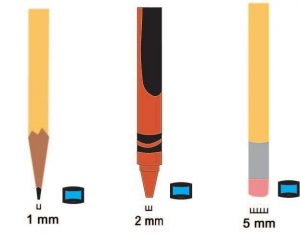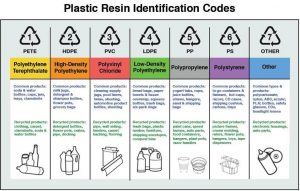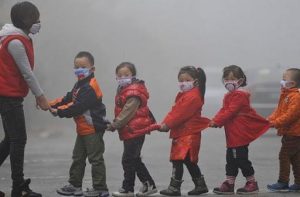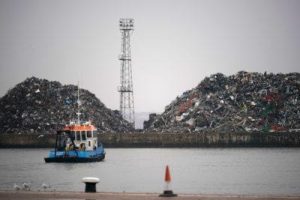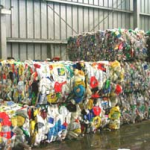Author: Arjun Shah, Bethesda Green Intern
Plastics: In your Hands or Not?
Picture this: you are walking into a store to buy some coffee. Once you are finished with the cup, you know immediately that it should be disposed of in its designated container- the recycling bin. But what if I told you that recycling in itself is an incomplete process? That the majority of products are not being recycled and the whole industry itself operates as a facade? The unfortunate reality is the materials you think are being recycled are most likely not being processed and refurbished at all; chances are it’s floating amidst a sea of trash in a body of water such as a local waterway, neighboring lake or bay or the world’s oceans. The other and equally destructive option is the shipped material ends up in a third world foreign country where the scrap is burned or recycled.
 Sourced from: myplasticfreelife.com
Sourced from: myplasticfreelife.com
The History of Plastic
Plastic was introduced in the 20th century as a cheap alternative to metal and glass in the household and manufacturers alike. Production ramped up after World War 2 as the world began becoming more and more globalized. The petrochemical industry was entering an increasing market for oil and natural gas to meet the world’s demand for cheaper, lighter household products. Petroleum is the key ingredient in plastic manufacturing. The process involves drilling and fracking to extract large amounts of oil and natural gas from the ground. The petroleum is then taken and sold to the plastics industry, where manufacturers use different chemicals to create a raw plastic called resin. Based on the extraction process, there are many organizations that take part in a process which converts fluid, raw ingredients into small, spherical pellets to be distributed to a variety of creations. Those pellets are the base ingredient for the creation and distribution of all the different plastic products. Consequently, they are also part of the global health crisis that plagues society today.
Blame Facade
The quantity of plastics entering the oceans, lakes and streams is quickly becoming undeniable. This is one of the impetus factors that started the recycling movement began in the 1970’s. Consumers were seeking ways to reduce plastic emission in the United States. There were multiple failures regarding the creation and disposal as plastics were globalized. The consumers and municipalities were ill equipped to dispose of and process the new materials, yet when the movement began, the first call to action was for the public to contribute and do their part all the while the production of the products and materials was ignored. The plastics producers and extraction companies contributed heavily to the first call of action to engage the consumer to start self-recycling. The issue was turned to the government, and the Environmental Protection Agency (EPA) needed to find a way to sustain the amount of plastic being thrown away and used on a daily basis. Many federally funded commercials were released to the public encouraging them to not be part of the problem. There was a disconnect over the cause of the problem. Was it the people’s fault for littering and causing the garbage to overflow? Or was it the producers who were continuing to make money and exploiting the environment for their own gain? Someone had to step in and stop the cycle… This was a national issue and the federal government’s job to get involved.
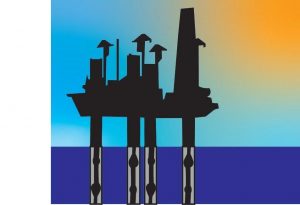 Offshore oil drilling rig, Image by Arjun Shah
Offshore oil drilling rig, Image by Arjun Shah
The Federal System’s Response to Influx
The EPA developed a recycling system designed to categorize and reduce plastic contamination to educate the public and municipal officials about what is recyclable and what is trash. It was divided into six different types of recycling. Plastic is usually a mix with many other chemicals and additives which create the type of object the consumer buys. There are 7 types (see the table below): Type 1 included products such as soda bottles and peanut butter jars. Type 2 products include laundry detergent and shampoo bottles. Type 3 examples are pipes and vinyl. Type 4 products are laundry baskets and plastic film wrapping. Type 5 product examples include yogurt containers and straws. Type 6 is Styrofoam cups, egg containers and other beverage containers. Type 7 is everything else miscellaneous including compostable utensils. To the normal person, these categories seem realistic and understandable.
The Truth
The truth is that recycling started as a virtuous endeavor to categorize and curb the flow of plastic in the environment. It was a system devised to address the public outrage at the amount of plastic pollution happening around the world. Only 3 out of the 7 categories are actually recyclable. So, recyclers from all around the world are only buying these three categories (1, 2 and 4) and paying the government for all its work. The local garbage collectors are taking the waste to a government owned recycling plant. Once it is processed, the recyclable material is being sold to recyclers globally. Recycling is a for-profit business and the most valuable items are uncontaminated soda bottles and paper products that yield the most return on investment. Unfortunately, not everything is cleaned after people perceive it as trash. The remaining materials are typically land filled or shipped overseas. However, soda bottles and cans are being recycled, the beverage industry pushed to make recycling mainstream and continues to support municipal recycling programs. All the major players in the recycling industry are profit driven with marginal regard for environmental impacts. Though recycling haulers have always been honest about what they are able to recycle, the public was unaware of the recycling problem due to one key player: China.
China’s Global Takeover
Around the same time public support grew for the Green Movement, China was going through a political movement. China began to properly industrialize and make changes to its previously low-demanding economy by becoming the materials collecting powerhouse that we know today. In the 1980’s, China began implementing many foreign policy changes which would impact the world for the next coming decades. One of these policies included importing plastic waste from all around the world to make the Chinese recycling industry flourish. By acting as the West’s recycling materials collections point, China secured a spot as recycling global superpower. Unfortunately, China was importing large amounts of low-grade plastic and using it as a fuel source by burning into crude petroleum and disposing the remaining in a landfill. Although there were actual Chinese recyclers taking material and recycling, the only categories recycled were 1, 2 and 4.
By the end of the 2010’s China was the most polluting country in the world. The air quality in the country was deteriorating and the people were beginning to notice. Major cities in China such as Chengdu, Kashgar and Hotan were amongst the most polluting cities in the world with an average air quality index of over 80 (PM2.5). The people were starting to take notice and public outcry for the issue to be resolved was heard by the government. A large proportion of contributions to the poor air quality were the amount of plastic being burnt into open air. Open air burning was a significant reason the Chinese government needed to take action. Chronic lung issues were on the rise and several health issues were linked to the toxic plastic pollution in air. The public health crisis outweighed the profit China was receiving by acting as the world’s plastics collection point. Chinese officials were compelled by the pollution produced by themselves that they could no longer afford to keep taking international waste. On 16 August 2017, China announced that it would no longer be taking 24 forms of solid waste from other countries such as paper and textiles and was implemented in January of 2018. There was a reckoning in the West about who was going to be the new source for their garbage as China had completely retracted from the waste industry. Recyclers in China were no longer burning foreign plastic, but they were also not able to recycle genuine materials from other nations either. China was officially done with plastic outside its borders.
Nations Hurry to Find Solutions
The ban had an immeasurable impact on the world as governments realized they could no longer send off all their recycling waste to China. All over the West large amounts of baled waste were piling up and storage space was running out. Other countries attempted to ease the pressure by opening their borders to the foreign plastic, mostly South Asian countries such as Malaysia, Indonesia and the Philippines. Quickly, they were overwhelmed by the immense tons of waste being sent their way with no infrastructure designed to process and sort material. Some countries rescinded the offer to accept material because it became unmanageable and started imposing laws to halt the practice. Malaysia announced in January of 2019 that it would no longer be accepting foreign imports of waste that were sent after China’s ban. In May of 2019, the Philippines also expressed that it would reduce the flow of plastic being imported into the country. The impetus that led to this decision was a dispute with Canada over the large imported stockpiles that were burdening the country’s infrastructure. Indonesia similarly had feuds over first world countries like Canada and the United States and thus began sending plastic to countries with fewer restrictions in South Asia such as India, Vietnam and Thailand. Indonesia then promptly also announced further restrictions on plastic. The restriction in other countries created unsustainable demand on those still accepting material and ended up pushing the problem off to other countries and is a process that continues to this day.
What Can We Do?
Obviously the problem is much bigger than one person or company but it would be incorrect to say each one of us is not part of the problem. This raises the question, what can I do? It is something I pondered over. How can I involve myself in a problem that seems to involve billions of people and billions of tons of waste? The information is available for those who care to look. Much reporting and discovery demonstrates the public need for change. The recycling system is broken and everyone needs to fix it. People need to be informed that plastic pollution is a much more prevalent issue than a person in the West might think. Since 14% of recycled products get recycled, there should be massive educational campaigns to unite the public against ‘wishcycling’. One way we can address the problem is by supporting laws that could have fundamental influence on the state of the world. Just like how China passed laws to ban foreign plastic, the United States can pass laws to aid in fixing the plastic problem. Many countries banned plastic bags and certain states are doing the same or imposing fines on buying bags. The bans decrease the impact on plastic waste production. The Break Free from Plastic Pollution Act aims to ban certain single use plastics completely and impose fines on carryout plastics. This is supposed to be a nationwide policy that is fighting its way to House and Senate floors. If this gets passed, it would revolutionize the plastic industry and reduce the largest contributor to plastic pollution: single use plastics. Other countries would follow suit and impose the same laws once they see the profound changes it would make to the world. Examples include significantly less single use plastics being thrown away globally such as food packaging. In the meantime, citizens can help by going to clean-ups to get rid of plastic overflowing waterways. If everyone began helping more, the problem would slowly, but surely be less life threatening to all life-forms of this planet. We started this problem decades ago and it has exponentially become worse; if it continues this way, it will continue to get worse. The time to act is now, the charade is up.
 Source: Rock Creek Conservancy
Source: Rock Creek Conservancy
References:
Albeck-ripka. (2018, May 29). Your recycling gets recycled, right? Maybe, or maybe not. Retrieved May 08, 2020, from https://www.nytimes.com/2018/05/29/climate/recycling-landfills-plastic-papers.html
Cheryl Katz, Katz, C., Bagley, K., Gaul, G., & Williams, C. (2019, March 7). Piling up: HOW CHINA’S ban on Importing waste has Stalled GLOBAL RECYCLING. Retrieved May 08, 2020, from https://e360.yale.edu/features/piling-up-how-chinas-ban-on-importing-waste-has-stalled-global-recycling
Cirino, E. (2019, April 22). What Laws Work Best to Cut Plastic Pollution? • The Revelator. Retrieved from https://therevelator.org/plastic-pollution-laws/
Cohen, J. (2020, February 11). Historic ‘Break Free From Plastic Pollution Act’ to Address the Plastic Pollution Crisis. Retrieved from https://www.plasticpollutioncoalition.org/policy
Conservancy, R. (2020, January 24). MLK mouth of Rock Creek (5). Retrieved May 08, 2020, from https://www.flickr.com/photos/loverockcreek/49434553373/
Dufour, F. (2018, December 20). A whopping 91% of plastic isn’t recycled. Retrieved May 14, 2020, from https://www.nationalgeographic.com/news/2017/07/plastic-produced-recycling-waste-ocean-trash-debris-environment/
Eschner, K. (2017, November 15). How the 1970s created recycling as we know it. Retrieved May 14, 2020, from https://www.smithsonianmag.com/smart-news/how-1970s-created-recycling-we-know-it-180967179/
Gokkon. (2019, December 10). Indonesia re-exporting illegal waste to other countries, report finds. Retrieved May 08, 2020, from https://news.mongabay.com/2019/11/indonesia-waste-plastic-export-import-illegal/
Jing, L. (2018, January 12). China is world’s worst polluting nation, officials admit. Retrieved May 14, 2020, from https://www.scmp.com/news/china/policies-politics/article/2051914/china-tops-world-air-pollution-and-carbon-emissions
Kao, E. (2018, October 02). 1 million dead and US$38 BILLION lost: The price of China’s air pollution. Retrieved May 14, 2020, from https://www.scmp.com/news/china/science/article/2166542/air-pollution-killing-1-million-people-and-costing-chinese
Pti. (2019, December 06). China most likely to become sole global superpower BY MID-21ST CENTURY: Mitt Romney. Retrieved May 14, 2020, from https://m.economictimes.com/news/international/world-news/china-most-likely-to-become-sole-global-superpower-by-mid-21st-century-mitt-romney/articleshow/72396044.cms
Rolfes, E., & Mas, K. (2019, March 12). Why you’re recycling wrong. Retrieved May 14, 2020, from https://www.vox.com/videos/2019/3/12/18252188/recycling-wrong-contamination-trash
Semuels, A. (2019, March 06). Is this the end of recycling? Retrieved May 08, 2020, from https://www.theatlantic.com/technology/archive/2019/03/china-has-stopped-accepting-our-trash/584131/
The story of plastic. (2019, October). Retrieved May 14, 2020, from https://www.storyofplastic.org/
World’s most polluted cities in 2019 – PM2.5 Ranking: AirVisual. (2019). Retrieved May 08, 2020, from https://www.iqair.com/us/world-most-polluted-cities
Yan. (2019, May 8). Philippines bans import of garbage from foreign Countries AMID TRASH dispute with Canada. Retrieved May 08, 2020, from http://www.xinhuanet.com/english/2019-05/08/c_138041061.htm



